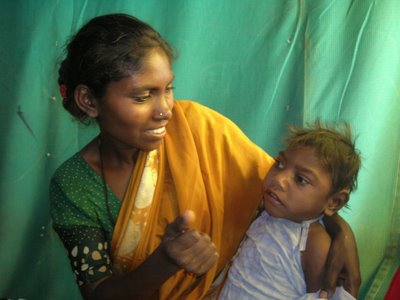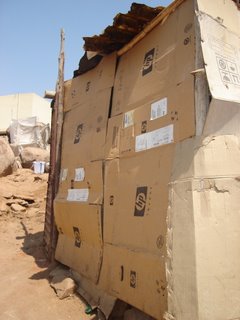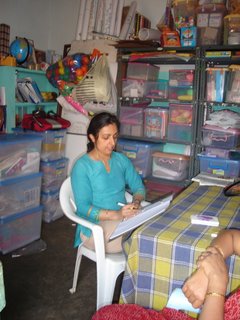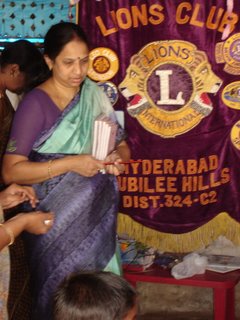 From the very start, the school was meant to attract special needs children. Along with child laborers, it was my dearest wish to use the school as a means to find these children. Special needs children give so much to those of us who have the chance to work with them. Ensuring they are medically attended to, educated to their abilities, loved, and cherished was a primary goal for me in developing this "model" school. It just would not be a model school unless capacity was built in to include all children.
From the very start, the school was meant to attract special needs children. Along with child laborers, it was my dearest wish to use the school as a means to find these children. Special needs children give so much to those of us who have the chance to work with them. Ensuring they are medically attended to, educated to their abilities, loved, and cherished was a primary goal for me in developing this "model" school. It just would not be a model school unless capacity was built in to include all children.Here is Aliya, four years old. He is living with cerebral palsy. Dr. Arati and I spotted him during one of the long mornings working with the students' various ailments. Aliya's mother was lovingly giving him a good, soapy scrub down during the usual bathtimes (10:30 AM, when the water is running). He clearly had CP. Aliya had no control of his limbs or head, and had difficulty extending his legs. He was also very thin. Since we could see right away his parents were not the problem, Dr. Arati thought it was a problem with swallowing his food. Aliya’s cubby little sister also was proof that the parents were doing all they could. However, the parents needed help. And they had not seen a doctor. Not ever. After a traumatic labor at a small local hospital near their village, followed by an emergency transfer and delivery (c-section) at a larger hospital, they were done with doctors.
Following our experience with Venkatesh (last post), where we were at a total loss for ideas on how to access health care these students and their families could actually afford, we repeated all the same mistakes. It was timing. We just had no time to work through the government hospitals to separate these whispered about “butchers” from the good doctors. (Good doctors do exist! I met a group of good doctors at a government maternity hospital in late 2005, and they really were outstanding.) Considering I wanted to operate as a magnet for children with medical needs, this was getting ridiculous.
 On that topic, how ridiculously funny is this hut! HP printer boxes! It is behind the tailor's hut, front hillside, bottom.
On that topic, how ridiculously funny is this hut! HP printer boxes! It is behind the tailor's hut, front hillside, bottom.Back to Aliya. We took him along with his fabulous, formidible grandmother to the local private children’s hospital for a formal diagnosis and recommendations. His mommy stayed home with the baby. He had everything you can imagine he would have: protein deficiencies, anemia, and deterioration of the optical nerves (lack of stimulation). The next step was to get him medically stabilized, which meant a few days and nights at the hospital to pump lots of good things into his system. They also ran checks on all his major functions. Fortunately, the one place the hospital recommended for in-depth diagnosis of his brain functions and long-term rehabilitation was a central government-run National Institute for Mentally Handicapped. NIMH which is free for families with a certain level of income. After a few weeks, he is still very, very strong.
Exhausted by the experience, but truly rewarded… Aliya smiled at us for the first time when he came home…we thought over how to make a game plan. The first thoughts are always to partner in these related areas to allow for greater concentration on the core mission of educating.
A PLAN!
Dr. Arati found resource that served the rural poor. This is a population that, most times, truly has no access to medical care. These people come in to the city, sick as any human can possibly be, collapse at the bus terminal, and a group called the Institute for Rural Health Studies sends out teams to find them. (www.irhs.org) The IRHS team of case workers carry the sick person through the entire process of finding doctors, going to appointments (difficult for people who are illiterate), working with specialists, and follow-up care. Since all our slum dwellers are recent arrivals or regularly migrate back and forth from their native villages, they fit in with that population IRHS serves. We initiated the process to refer our very sickest children to them.
 We are currently filling out Aliya’s referral to IRHS. Here is Dr. Arati writing up his case history. The next cases we will refer are a beautiful young girl with a benign brain tumor which is impacting her cognitive and motor development, along with baby Said (see previous posts) who has a club hand.
We are currently filling out Aliya’s referral to IRHS. Here is Dr. Arati writing up his case history. The next cases we will refer are a beautiful young girl with a benign brain tumor which is impacting her cognitive and motor development, along with baby Said (see previous posts) who has a club hand.IRHS will free us up to concentrate on how to integrate special needs children into the school. Thank you!
More information on IRHS can be found on www.irhs.org and they accept donations on-line (PayPal). Every dollar goes to providing health care to the poor, the director does not even draw a salary. In addition, they do outstanding public health research. If there are any doctors who want to spend some quality time gaining field experience, IRHS is a great place to do this. Non-medical types can volunteer for construction of clinics, management issues, and gathering field data.
 Back at the school, we have stepped up our partnership with the Jubilee Hills Lion’s Club. They hold a free clinic every Monday with inoculations and medicines provided by a doctor and government nurse. They are yelling at us for not sending them more students to take care of! I love them! We will send them less severe cases, like asthma sufferers and skin aliments.
Back at the school, we have stepped up our partnership with the Jubilee Hills Lion’s Club. They hold a free clinic every Monday with inoculations and medicines provided by a doctor and government nurse. They are yelling at us for not sending them more students to take care of! I love them! We will send them less severe cases, like asthma sufferers and skin aliments.Here is Aruna from the Lion's Club in action at the school in late 2005. She is all ready to set up health camps for the children. She wants to go a step further and offer HIV/AIDS testing on a regular schedule for the parents since many of the daddies are putt-putt drivers, a population which is at greater risk for HIV.
Dr. Arati will continue to scout for cases, treat them, and/or then shift them to either IRHS and the Lion’s Club
Today, we met a new little special needs boy. Prasad, age seven, came in with his lovely mother from his village south of the city. He is also living with CP, but he does have some control over his arms and head. Now we know what to do.
Comments
Post a Comment
Leave a Message